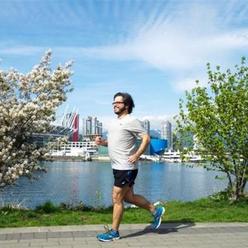Keeping with my new marathon shoes theme this week, here are some tips on how to choose your next pair of running shoes.
Transcript: How to Choose Running Shoes
1. Know Your Running Shoes
Road Running Shoes:
- For pavement and surfaces with only slight irregularities
- Light and flexible
- Cushions or stabilizes feet
Trail Running Shoes
- For off-road routes
- Enhanced with aggressive out-soles for solid traction
- Fortified to offer stability and underfoot protection
2. Know Your Feet
Know Your Ankles
Pronation affects the sideways motion of your foot as it propels the foot forward
ROLL IN (over pronate): Choose shoes with motion control and extra stability
ROLL OUT (under pronate): Choose shoes with cushioning and flexibility
Know Your Arches
The height of your arch can affect the direction your ankles roll (pronation):
- HIGH: your ankles probably under-pronate
- FLAT: your ankles probably over-pronate
- ARC DE TRIUMPH: you are in France 🙂
3. Know Your Environment
Running Surfaces
Like tires, outsoles are designed to accommodate certain surfaces.
I Run On:
- ROADS: choose shoes that are light, flexible and cushion my feet
- TRAILS: Choose shoes that offer stability and traction with study outsoles
What Drives You?
Keep track of your speed and distance to determine the lifespan of your running shoes.
The Reason I run is:
- For fitness, fun or exercise—shoes get minimal usage
- Increased speed—shoes get extra wear and tear
- Improved endurance—shoes need to be comfortable for the long haul
- Triathlete/marathon training—shoes need to be versatile
- To escape from bears 🙂 —shoes need optional nitrous switch
Is is time for new running shoes?
An average running shoe lasts between 300 and 500 miles, or 3-4 months.
4. Lacing Techniques
Hammer Toes
- Lifts up toe box to help toes from curling down
Heel Slipping
- Locks heel into place to reduce blisters caused by excess heel movement.
High Arches
- Removes pressure points on sensitive nerves on the top of the foot
Cats Cradle 🙂
- The world record Cat’s Cradle is 21,200 in 21 hours
5. Know Your Shoes
Tips for trying on running shoes:
- A thumbnail’s length of space in the toe box allows room for normal swelling and running downhill.
- Try on shoes at the end of the day, when your feet are at the largest.
- Use orthodics? Bring them when trying on running shoes.
- Get improves cushioning and stability with custom insoles, like Superfeet or Spenco.
6. Know the Numbers
Fast Facts
- 9.58 seconds: 100-meter world record
- 3:35:27.2: 50,000 meters walking world record
- 70-75 mph: by the way, a cheetah can accelerate faster than a Ferrari Testarossa (0-60 in 3 seconds)
Fun Facts
- Human foot & ankle:
- 26 bones
- 33 joints
- 100+ muscles, ligaments & tendons
- 10,000 steps a day = 100,000 miles per lifetime (=4x the circumference of the earth!)
- 250,000 foot sweat glands produce 1/2 pint of sweat per day
- 10.35 inches: average length of a man’s foot
Sources:
- REI Expert Advice
- Profoot.co.uk
- Wikipedia











